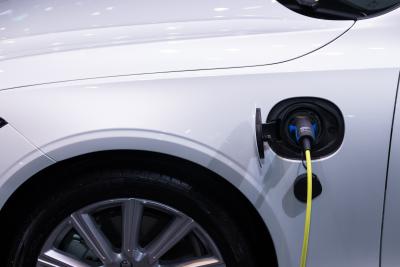Autor: Dr. David Novak
Abstract
Purpose:
In the context of global overheating (belittling it as “climate change”), the entire mobility sector, which also includes private individual transport, must make its contribution to decarbonization (goal: 0-CO2 emissions). Politicians, against their better judgment, chose e-mobility as the only conceivable solution and finally decided on it and are now surprised that many drivers cannot, do not want to and perhaps will not opt for this type of technology.
Design/methodology/approach:
The aim was to briefly examine why e-cars in Germany are falling short of the sales figures targeted by politics and why the majority of drivers are obviously only motivated to a very limited extent to switch to pure e-cars.
Findings:
Over the years, German politics had set very ambitious goals for the switch to the supposed/alleged 0-CO2 technology of e-mobility. The changeover is only comparatively slow; politicians blame the drivers and at the same time are relatively uninterested in the reasons. The drivers feel completely forgotten during the typical use of its cars, expressly also for long holiday trips, which is proven beyond a doubt by a self-conducted calculation based on various examples.
Affected countries:
The situation described here, which is largely based on Germany, should be relatively easy to transfer to most EU countries because the situation there is comparable or at least similar.
Research/Future/Practical Implications:
E-cars will certainly play a significant role in the future. It is possible that the way cars are used, or by their owners, will (have to) change. Perhaps other types of energy or drive systems such as hydrogen H2 and SynFuels will play a much stronger role, which neither the politicians and journalists responsible today want to see, nor what many car manufacturers and suppliers, nor manufacturers of infrastructures are prepared.
Originality/value:
Currently there are practically no scientific books on the use or rejection of e-mobility. Therefore, only current surveys, market quantities and obvious behaviors of users and challenges can be described here.
Keywords
climate change, electric cars, renewable energies, hydrogen H2, decarbonization
JEL codes: L62, Q01, Q42, Q49, Q54, Q56, Q57, R41.
Introduction
The worldwide climate change (correctly it should be called “earth overheating”, this term was significantly coined by Volker Quaschning, Prof. at the HTW Berlin) is essentially based on the emission of climate-damaging gases, primarily CO2 and methane, whereby in this paper only CO2 is referred to is taken. Approximately ⅓ of global CO2 emissions are based on mobility (via air, rail, water and road). Since normal road traffic in particular is the focus of media reporting and thus also the considerations of numerous politicians, they have dedicated themselves to this area in particular. Their most urgent goal is the reduction of CO2 emissions, which is decisive in private transport. This task is coupled with the fact that most parliamentarians do not have a technical background (in the Austrian parliament the origin from industry and production is just 4.4% (Parlament), in other parliaments it should be comparable, if not significantly lower). This situation means that neither existing nor new technologies can be properly assessed and many decisions are made based on political guidelines or personal moral conviction, but not on the basis of technical and implementable meaningfulness. This problem may apply to a large part of all parliaments in the world, including, for example, that of the US state of California (Rokadiya, 2019) (Note: California because the parliament there has decided that only cars without exhaust pipes and thus automatically without combustion engines, could be emission-free, a decision that systematically prevents openness to technology and obviously also proves the lack of technical understanding of the parliamentarians there).
Sustainability in Private Transport from a Political Point of View
For many politicians, from a climate point of view, a clean car consists above all of the possible fact that it does not emit any greenhouse gases (mainly CO2) while driving. As a result, a pure electric vehicle (BEV) is considered clean because it has no exhaust (California Legislative Reasoning, California Air Resources Board (CARB) legislation) (Reif, 2014). In an emergency, nobody knows where the electricity originally comes from in an individual case, at least not really, because the electricity for the car ultimately comes from the charging station. And this usually draws the electricity from the public power grid. To be fair, one would have to come to the conclusion that the CO2 emissions of an e-car correspond to the average CO2 pollution per kWh in the respective country. This factual, neutral and understandable point of view is obviously not favored by politicians, at least at EU level. Since internal combustion engines (we are talking here about combustion engines of petrol or diesel, i.e., carbon-based fuels) obviously emit CO2 and the aim of the EU is, at least permanently, to rely on renewable energy sources, such as primarily solar and wind, and to a very limited extent also geothermal energy, as well as non-renewable energies but de facto without CO2 emissions such as nuclear energy, in the case of e-cars the realistic probability that purely regenerative energy sources were used for charging is practically zero. The decision was thus made at EU level: all electric cars are basically clean (CO2 emissions = 0) and all cars with combustion engines (according to the definition, there are only carbon-based fuels) generally emit CO2, are therefore dirty and therefore closed in the medium term to forbid. The fact that hydrogen H2 and/or synthetic fuels (SynFuels) can also be used for CO2-neutral propulsion was obviously not part of the considerations and/or knowledge of the responsible parliamentarians when this resolution was passed. At the time, the completely simplified and incorrect decision was made: all electric cars are good because they are generally and without exception clean; all non-electric cars are combustion cars and these are bad because they generally emit CO2. This scientifically untenable definition applies to the entire EU. It is currently not possible to say when/whether the EU Parliament will deal again with evaluating H2 and SynFuels as (obviously CO2-free and therefore clean) fuels.
Development of sales figures for electric cars within the EU
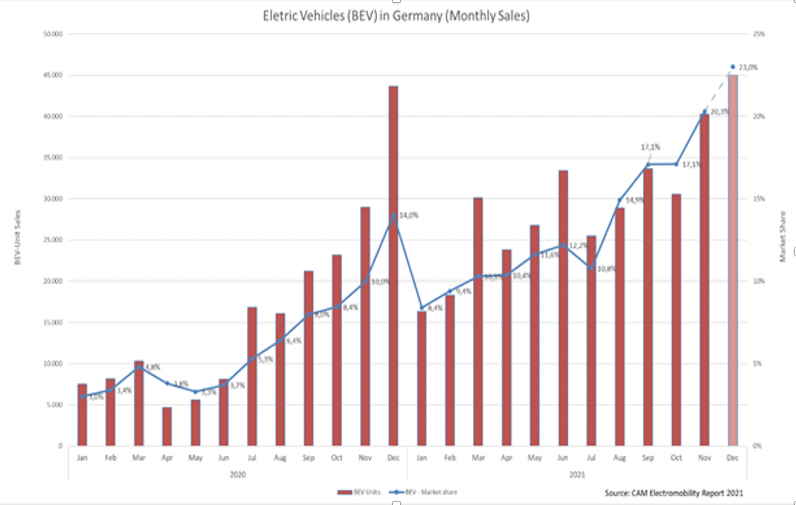
Figure 1. Quantity of New Registrations of Pure Electric Cars (BEVs) in Germany 2020 and 2021. (CAM Electromobility, 2021)
After all, in Germany (by far the largest car market in the EU) some >25% of registered new cars are now also equipped with electric drives (of which approx. 50% are plug-in hybrids with large combustion engines, i.e., only approx. 13% in total pure e-cars/BEV), but no more. It is difficult to predict whether the growth trend shown here will continue, especially since it is currently not clear how the prices for electricity, for conventional fuels (petrol and diesel), and for new fuels (hydrogen H2 and SynFuels) and the associated technology, will be developed. On the other hand, one of the findings from these figures is that ¾ of all car buyers still decide against an e-car/BEV. And obviously there must be reasons, and probably quite valid ones, because politicians and German journalists regularly praise e-cars, and those with CO2 emissions are systematically criticized as bad or morally reprehensible. One of the possible reasons could be the still very manageable infrastructure for public charging stations.
Given the fact that Germany had around 45,000 public charging stations by the end of 2020, of which only around 15% were fast charging stations (note that with around 50 million cars and the need for a long charging time), a problem may already be apparent as to why drivers buying a new car decide against a purely electric car (BEV). There are simply not enough (free) charging options, at least from the point of view of potential buyers. (Gebhardt, 2022)
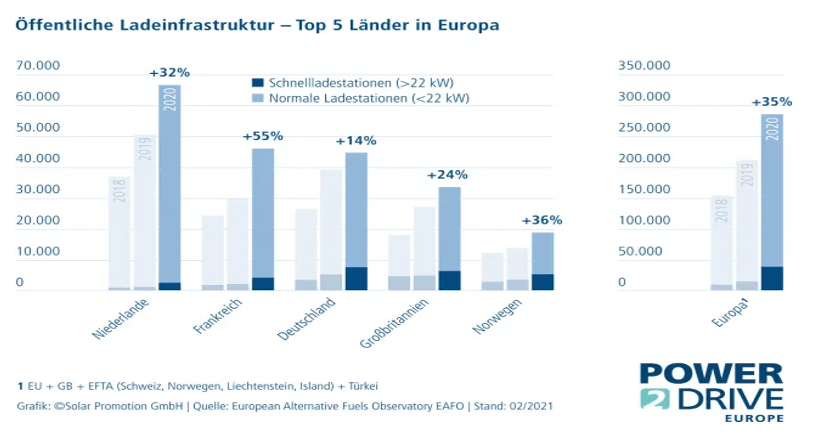
Figure 2. Public Charging Structure for e-cars. Germany Middle Column with Approx. 45,000. (Solarserver, 2022)
Reasons for Lack of Enthusiasm for Electric Vehicles (BEVs) among Potential Customers (Gebhardt, 2017)
So Far, There Has Been a Lack of Infrastructure and Long Loading Times
For the increased use of electrically powered vehicles, there is still a correspondingly dense network of electric charging stations (see above). These are essential, especially in the larger cities, where many people live in multi-storey buildings and have no possibility to charge at home. Underground parking spaces would have to be equipped with appropriate sockets and billing systems in order to avoid bottlenecks at the few charging stations that are still available today. But even if you have your own parking space or garage, it must first be checked whether this is currently suitable for charging an electric car at all or whether there is a corresponding charging and power grid infrastructure (necessary high-voltage lines through the energy provider) must be created. The problem with garages in particular is likely to be massive in Germany and not necessarily comparable to other countries, especially those where a high percentage of the population owns a larger home that also includes a detached garage. In addition, in Germany, the wall box required for charging cannot simply be operated with solar energy, since the solar radiation is discontinuous and very rare in winter. Therefore, all garages would have to be provided with a power line - costs that have not yet been discussed at all, neither for the population in general, nor for private households/garage owners in particular.
The charging times can also be very long, depending on the size of the battery and the charging technology. From several hours via the normal “Schuko”-plug of the household socket to less than an hour at a public fast charging facility. But this still takes much longer than the previous typical refueling process of a conventional combustion engine.
For a long time, the leading US manufacturer of electric vehicles Tesla has also been experimenting with a concept in which the empty battery is simply to be exchanged for a full one. The first attempt to replace the battery, which was supposed to be fully automatic and should take less than two minutes, was rejected at the time due to the alternative supercharger technology. But Tesla hasn’t given up the concept of battery swapping yet. With their newly developed concept, about 15 minutes are estimated for changing the battery and can be used on the Tesla S and X models with an easily accessible battery in the underside of the body. The Model 3 intended for the mass market, on the other hand, is not prepared for this. It therefore remains more than questionable whether the concept will really be rolled out across the board and represent a real alternative to the charging process. There are no plans for this in the EU.
Increased Risk of Accidents with e-cars due to the Lack of Driving Noise
From the point of view of environmental and consumer advocates, the largely absent noise development is very welcome. However, it harbors an often underestimated danger for pedestrians and cyclists. Often focusing on the smartphone, they increasingly rely on hearing when they want to cross the street, for example. An electric vehicle that cannot be heard can mean danger to life and limb for this clientele, at least in the transition phase. Whether new regulations regarding artificially generated vehicle noise make sense is a matter of controversial public debate.
Electric Cars Are Expensive to Buy
The price driver for the electric car is still the battery, which is also where the greatest added value lies (most of the profits from an electric car are currently only made with the batteries and these are, at least for German cars, exclusively produced in China, where then all the profits also flow (Fromm, 2021). In addition, there are only a few companies worldwide that can provide complete production with all stages. Given the low production quantities of electric vehicles to date, many automobile manufacturers do not even want to invest in correspondingly expensive production facilities, at least not without a partner. Even though Tesla has recognized for itself how important it is for future electro mobility to have its own battery production, they also have Panasonic on board as a partner at their Gigafactory. With the increasing popularity of the electric car, more large battery factories will probably come into being and, in connection with new battery technology, prices will fall (assumed economies of scale). For the time being, however, despite state subsidies, electric vehicles remain expensive because of the batteries. The extent to which e-cars hold up in a direct total cost comparison with comparable models with combustion engines depends both on the calculation models and their numerous variables (which can vary greatly depending on the country but also on usage behavior), as well as on the daily updated energy prices at filling stations and charging stations.
BEVs still Have Insufficient Ranges (Wieler, 2022)
Above all, electric vehicles with low battery capacities give rise to what is known as “range anxiety” among their owners. The lack of range of the electric vehicle is intensified by a hitherto inadequate network of charging stations (currently only a maximum of approx. 45,000 in Germany and a maximum of 480,000 throughout Europe) (Electromaps.com). Author’s note: The published figures vary greatly.
Proponents point out that the ranges are absolutely sufficient for 80 percent of all road users: the average distance traveled by this group is a maximum of 80 kilometers per day. However, with electric cars there are sometimes significant deviations from the theoretical range specified by the manufacturer and the actual range in everyday life (see also the tables created here). In addition, batteries are very susceptible to cold outside temperatures, which also affect the range. No wonder, then, that range anxiety is so widespread. Note: Here it depends on the planned use: Short ranges are not a problem if the car is generally not used for longer vacation or business trips and you can charge it daily at work or at home without any problems.
Lack of Long-term Experience in Electro Mobility
In a conventionally powered automobile, a lot has happened over the years. It is known how long the vehicle usually lasts, what costs are incurred over time, who is responsible for maintenance, what value development can be expected, etc. With an electric car, on the other hand, there are still many unknowns due to a lack of experience. For example, questions about battery life or the value of a used electric vehicle in five years are important questions that buyers ask before making a purchase. Replacement batteries currently cost an unbelievable €15,000-€20,000 (Wildberg, 2022), plus assembly costs, mind you. So if the battery breaks and there is no guarantee on it, the car, at least used, is practically a total loss. A problem that has not yet been solved, at least not in the interests of e-car users.
Customer Benefit—the Influence on the Purchase Decision (marketinginstitut.biz)
In order to understand why a potential customer decides for or against something, you have to delve a little deeper into marketing. Only one factor is really important: the benefit. This differs in the basic benefit (in the case of a car, how do you get from A to B, provided that you can afford it financially) and the additional benefit such as fun, design, comfort, practicality, engine performance, etc. The basic benefit is always in the foreground, possible additional benefit (can vary greatly from user to user), only comes at 2nd to n.-place. So the potential buyer only and exclusively looks for the basic benefit. However, if this is significantly impaired, e.g., due to a massive loss of time, or the risk of not being able to find a free and functional charging station in a short distance, then the basic benefit drops to a very large extent, right down to zero. And if that is the case, then the potential buyer’s interest in buying such a car also decreases.
So if car manufacturers, car associations and responsible politicians, as well as journalists, who see it as their task to educate the people (very typical for Germany), ask themselves why BEV sales are not achieving the desired sales figures, then this is exactly where the cause is to be found: In the lack of basic use with BEVs, not only in the limited range, but also in the massive loss of time when refueling, which is the charging process of the battery here.
The fact that there is also the problematic loading at home must also be mentioned. Approximately 38% of all car owners in Germany (Pawlik, 2021) park their car outside because they have no garage space. Question: Where should they then let their BEV charge for hours? How do they get home from the charging station and back to pick it up? And for the garage owners: How many of these garages, or even just parking spaces in large garages, have a power connection at all and then also a suitable high-voltage connection (high-voltage current with 400V)? In Germany, according to law for power lines (§§ 903 BGB (German Civil Code)) for public areas (must be entered in the land register and certified by a notary), a high-voltage connection can practically only be laid by the responsible energy supplier (Bassenge, 2014). As long as these practical problems for the feasibility of e-mobility are not solved, one should not be surprised at the lack of willingness to buy BEVs. The obvious problems are obvious.
Examples of Lack of Benefit from Potential Customers
Whether a customer decides for or against a product is usually not only based on the positive benefits (advantages), but also on possible specific disadvantages in use (see above). These can be completely different between customers. In principle, however, there are disadvantages for a customer that the customer perceives as blatant, up to the point that a disadvantage makes it impossible to use the product for an application (loss of basic benefit), with this disadvantage then de facto being a kind of veto for the potential customer becomes much more important than possible advantages (less important additional benefits). A typical example of an e-car is not just a relatively short range, but much more problematic, the long charging time of the battery. Below are a few examples that are based on facts and that every potential e-car buyer will be aware of before they make the long-term decision to buy a car that is usually very expensive for them.
Approach by the author, all calculations performed by him:
1. The 1st column in Figure 1 shows the “maximum theoretical range” in km specified by the manufacturer. These ranges are not determined on roads, but exclusively on test stands, where they take place under optimal laboratory conditions that are beyond any reality (Helvetia.com). Examples of this: it is constantly 20 degrees C, the car is not loaded (max. 1 rather light person), during the day (i.e. no light), all other electricity consumers such as radio, navigation device, seat heating, rear window heating and especially air conditioning are generally completely switched off, the speed is then, for example, constant at 80 km/h or something similar, even if the new WLTP test is somewhat more practical than the previous NEDC test (Diethelm, 2021). Since these measured values are practically unachievable under real conditions, a flat rate of 20% is subtracted from them in column 2 to show a “realistic theoretical range”. If you drive in reality, you can’t run the battery completely empty, because you don’t know exactly where the next functioning and also free charging station is. Therefore, 20% was deducted from the realistic range here, since a considerable safety reserve is required. This results in the 3rd column “actionable realistic range”. This range therefore indicates the maximum quantity of kilometers that should be planned when you reach the next charging station.
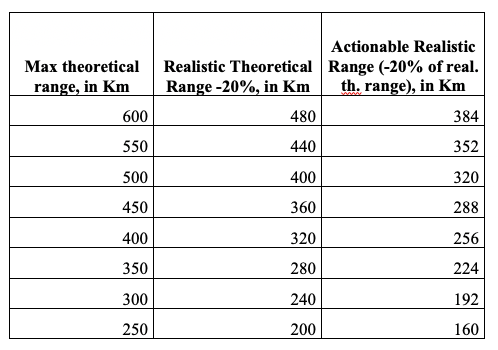
Figure 3. Maximum and Realistic Ranges for Electric Cars in Km. Source: own calculation.
Now let’s take the above example and plan a vacation trip. The starting point is the city of Hanover (Germany), which is relatively centrally located within Europe. The specified destinations are Mayrhofen in Austria for skiing (winter) and destinations in Italy, France and Spain for summer vacations.
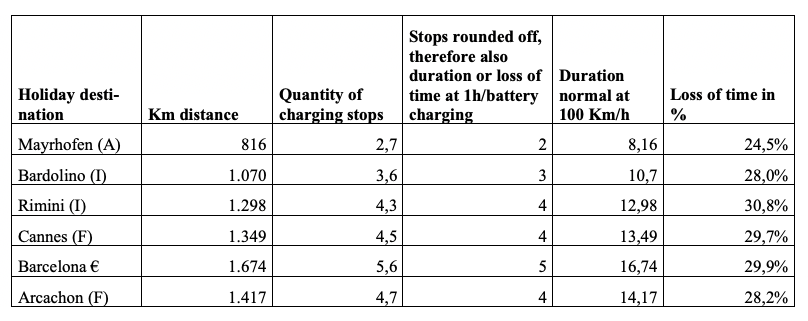
Figure 4. Examples of Ranges for Holiday Trips from Hanover, Germany (according to Google Maps). Calculation of Lost Time (in h) on Holiday Trips with e-cars. Source: own calculation.
Based on the above calculations, a feasible, realistic range of an “average of 300 km” was assumed, which should definitely be in the upper possible range. The “quantity of charging stops” in column 4 has been rounded down, as it is assumed that you start with a fully charged battery. The time it takes to fully charge the battery was assumed to be “1 hour”, which is definitely too optimistic, but simplifies the calculation here. Column 5 “duration” gives the “normal travel time”, assuming an average speed of 100 km/h. The very optimistic “additional time” from column 4 of “1h/charging process” must then be added to this (if only 80% is charged within 1h, the ranges decrease even further, which correspondingly increases the quantity of charging processes and thus the loss of time even further). Dividing this by the normal length of time gives the percentage of “lost time”, column 6. This is on average between approx. 25% and 30%. And it is precisely this loss of time that is likely to deter many potential buyers from buying an electric car. And there are other problems such as: 1). far too few charging stations at the motorway petrol stations; 2). broken charging stations or at least not working properly; 3). charging stations occupied by other users or 4). most hotels without their own charging stations, not even mentioned yet, as well as 5). disproportionately higher consumption of electric power when driving at night and in winter with a full load (typical for skiing holidays in winter), 6). full closures of motorways in the event of serious accidents (in winter) or 7). the very discontinuous distribution of charging stations in Europe, so that large areas of states are not covered (Kammerer, 2017).
Realistic Cost of Electric Cars
A very large comparison test by the ADAC (Kroher, 2021) (largest German automobile club and second largest in the world) about the realistic costs came out that assuming the considerable subsidies by the German state for the purchase of electric cars until 2025 apply, a price per kilometer for typical mid-range vehicles was between 40 and 60 Euro cents. A value that most similar vehicles from the same manufacturer but with an internal combustion engine (petrol or diesel) exceeded by around 10% to 20%. To be fair, however, it must be pointed out here that 1. the cars in the test were not always comparable 1:1 and 2. numerous costs are not known, such as the frequency of damage and the extent of damage in the case of e-cars (there are no comparable empirical values available yet), as well as a possible repair and/or even disposal of the battery. Also, the vehicle fires of e-cars, which have occurred relatively frequently up to now, cannot be adequately assessed financially. On the other hand, the prices for fossil fuels are currently increasing at an explosive rate to unprecedented heights. Electricity prices are also rising, albeit less rapidly. It is currently not possible to judge how the electricity price will develop, which will then also include the still mandatory switch to renewable energy sources. The most diverse variables are interesting, also with regard to the very different prices at the charging stations.
Conclusion (theses)
- There are currently no uniform definitions of when a car is clean (0-CO2 emissions) and when not. Bans on openness to technology (California’s Parliament), or unilateral decisions such as that all BEVs emit 0-CO2 because they can, at least theoretically, only be charged with green electricity (EU Parliament), are basically not sensible for a really factually neutral assessment.
- The quantity and increase in BEVs sold, as well as the required charging stations, is proceeding too slowly and obviously does not achieve the desired political goals, neither in Germany nor in the EU.
- There are several very significant reasons for the lack of enthusiasm among potential buyers for electric cars BEVs.
- Those responsible in politics and at the manufacturers obviously did not sufficiently examine the required basic benefit for the motorists in advance and also did not realize that a missing mandatory basic benefit cannot be compensated for by other additional benefits.
- The assumption that all/many drivers could easily charge their BEV in their own garage on/in the house must be judged to be absolutely unrealistic.
- The calculations carried out by the author himself clearly show that a massive increase in driving time has to be accepted on long holiday trips with BEVs, which significantly reduces the basic use of the car (problem-free driving from A to B). The calculated figures are clear and understandable for everyone.
- The overall costs for BEVs, especially with regard to repairs and even more so the large and expensive battery, are currently an incalculable risk for buyers.
Overall conclusion: The reasons mentioned clearly show why e-cars are still struggling on the markets (Germany and EU) (current share of only 25% (only 13% are BEVs) of new car sales) and also expressly why buyers are still largely reluctant to buy BEVs.
References
Bassenge, P., & Palandt, O. (2014). BGB-Kommentar, 24. Auflage, § 905 Rn. 2. C.H.Beck, München, Germany.
Homepage Helvetia.com. (n.d.). E-Auto Reichweite – so weit kommen Sie mit ihrem Elektroauto. Switzerland. Retrieved March 16, 2022, from https://www.helvetia.com/de/web/de/ratgeber/fahrzeuge/e-car/versicherung-foerderung/e-auto-reichweite.html.
Homepage electromaps.com. (n.d.). Alle Ladestationen. Retrieved March 16, 2022, from https://www.electromaps.com/de/ladestationen
Homepage DIM Deutsches Institut für Marketing GmbH. (n.d.). Kundennutzen – Der Einfluss auf die Kaufentscheidung. Retrieved March 16, 2022, from https://www.marketinginstitut.biz/blog/kundennutzen/#2_die_verschiedenen_ebenen_des_kundennutzens_gesamtnutzen_vs_zusatznutzen
Reif, K. (2014). Ottomotor-Management, Bosch Fachinformation Automobil (p. 328). © Springer Fachmedien Wiesbaden, Germany.
Kammerer, S. (2017, September 23). Elektroautos: Vor- und Nachteile. Retrieved February 10, 2022, from https://www.homeandsmart.de/elektroautos-vorteile-nachteile
Rokadiya, S., & Yang, Z. (2019, April). Overview of global zero-emission vehicle mandate programs. Retrieved March 17, 2022, from https://theicct.org/wp-content/uploads/2021/06/Zero-Emission-Vehicle-Mandate-Briefing-v2.pdf
Pawlik, V. (2021, January 28). Umfrage unter VW-Fahrers in Deutschland zu Unterstellmöglichkeiten von den/die PKW. Retrieved March 17, 2022, from https://de.statista.com/statistik/daten/studie/892382/umfrage/umfrage-unter-vw-fahrern-in-deutschland-zu-unterstellmoeglichkeiten-fuer-den-die-pkw/. Bundesamt für Statistik (statista.com).
Homepage Solarserver.de (2021, March 04). Power2Drive: Ladeinfrastruktur boomt in Europa. Retrieved March 16, 2022, from https://www.solarserver.de/2021/03/04/power2drive-ladeinfrastruktur-boomt-in-europa/
Fromm, Th. (2021, September 10). Chinas riesiger Vorsprung bei den Autobatterien. Retrieved March 12, 2022, from https://www.sueddeutsche.de/wirtschaft/elektroautos-batteriezellen-catl-tesla-1.5406590
Kroher, Th. (2021, October 27). Kostenvergleich Elektro, Benzin oder Diesel: Lohnt es sich umzusteigen? Retrieved March 11, 2022, from https://www.adac.de/rund-ums-fahrzeug/auto-kaufen-verkaufen/autokosten/elektroauto-kostenvergleich/
Bratzel, St. (2021, December 16). E-Mobilität in Deutschland 2021. Retrieved March 16, 2022, from https://auto-institut.de/category/automotiveinnovations/emobility/. (Original work: CAM Electromobility Report 2021)
Diethelm, M. (2021, December 24.). E-Autos im Autobahn-Test: Mit diesen 10 fahren Sie am weitesten. Retrieved March 16, 2022, from https://efahrer.chip.de/news/e-autos-im-autobahn-test-mit-diesen-10-fahren-sie-am-weitesten_105648
Wieler, J. (2022, January 14). Elektroautos im Test – so hoch ist der Stromverbrauch. Retrieved March 15, 2022, from https://www.adac.de/rund-ums-fahrzeug/tests/elektromobilitaet/stromverbrauch-elektroautos-adac-test/
Parlament Republik Österreich, Homepage. (2022, January 21). Statistik der Abgeordneten zum Nationalrat. Retrieved March 17, 2022, fromhttps://www.parlament.gv.at/SERV/STAT/PERSSTAT/BERUF/aktuell_NR.shtml. Austria.
Gebhardt, J.-K. (2022, February 02). E-Auto-Ladestationen: Zu wenig Ladepunkte für zu viele E-Autos. Retrieved March 16, 2022, fromhttps://www.autobild.de/artikel/ladestationen-fuer-e-autos-ladenetz-ranking-ladepunkte-pro-auto-18630173.html
Wildberg, R. (2022, February 21). So teuer sind Tausch-Akkus für Elektroautos. Retrieved March 12, 2022, from https://www.autobild.de/artikel/akkutausch-beim-e-auto-kosten-einbau-garantie-21232250.html
Cover-Picture
Rathaphon Nanthapreecha, by Pexels.com.

